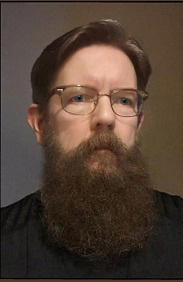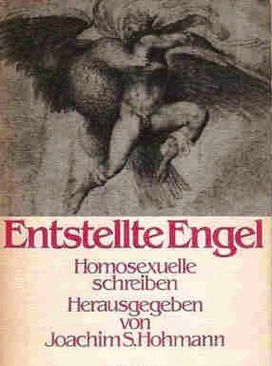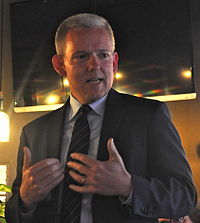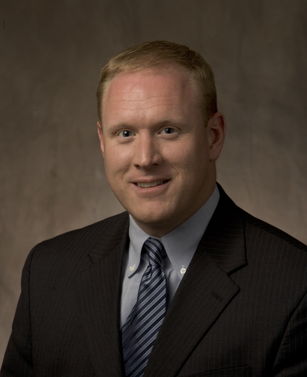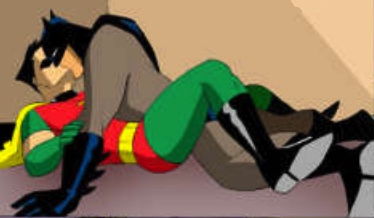|
presents THIS DAY IN GAY HISTORY based on: The White Crane Institute's 'Gay Wisdom', Gay Birthdays, Gay For Today, Famous GLBT, glbt-Gay Encylopedia, Today in Gay History, Wikipedia, and more …
Collected by Ted August 19 [{(o)}]|[{(o)}]|[{(o)}]|[{(o)}]| [{(o)}]|[{(o)}]1867 – Germany: In Munich, Karl Heinrich Ulrichs is jeered when he attempts to persuade jurists that same-sex love should be tolerated rather than persecuted. He is probably the first to come out publicly in defense of what he calls "Uranism" (homosexuality). Ulrichs coined various terms to describe different sexual orientations, including Urning for a man who desires men (English "Uranian"), and Dioning for one who desires women.
1909 – On this date the Polish writer Jerzy Andrzejewski was born in Warsaw (d.1983). He studied Polish language and literature from 1927 to 1931 at the University of Warsaw. Two of his novels, Ashes and Diamonds, about the immediate post-war situation in Poland, and Holy Week, dealing with the Warsaw Ghetto Uprising, have been turned into film adaptations by the Oscar-winning Polish director Andrzej Wajda. His last novel Miazga (Pulp), dealt with homosexuality, and could not be published in Poland due to legal prohibitions. It was published only abroad in its uncensored version. Although he was frequently considered to be a front-runner for the Nobel Prize for Literature, it was never awarded to him. He reportedly suffered from alcoholism, that during his later years may have hindered his literary production. Andrzejewski, who was gay, died of a heart attack in Warsaw, 1983. On September 23, 2006, Andrzejewski posthumously received the Commander's Cross of the Order of Polonia Restituta from Polish President Lech Kaczynski.
He is a graduate of the Lawrenceville School and Princeton University, where he donated the money for Forbes College, one of the five residential colleges at the University. After dabbling in politics, including a term in the state legislature and candidacy for Governor of New Jersey, he committed to the magazine full time by 1957, three years after his father's death, and after the death of his brother in 1964 acquired sole control of the company. The magazine grew steadily under his leadership, and he diversified into property and other ventures. One of his last projects was the magazine Egg, which chronicled New York's nightlife. (The title had nothing to do with Forbes's famous Fabergé egg collection.) Malcolm Forbes was legendary for his lavish lifestyle, his private jet, ever larger Highlander yachts, huge art collection, substantial collection of Harley-Davidson motorbikes, his French Chateau (in Balleroy, Normandy), his collections of special shape hot air balloons and historical documents, as well as his opulent birthday parties. He chose the Palais du Mendoub (which he had acquired from the Moroccan government in 1970) in the north-western city of Tangier, Morocco to host his 70th birthday party. Spending an estimated $2.5 million, he chartered a Boeing 747, a DC-8 and a Concorde to fly in eight hundred of the world's rich and famous from New York and London. The guests included his friend Elizabeth Taylor (who acted as a co-host), Gianni Agnelli, Robert Maxwell, Barbara Walters, Henry Kissinger, half a dozen US state governors, the CEOs of scores of multinational corporations likely to advertise in his magazine. The party entertainment was on a grand scale, including 600 drummers, acrobats and dancers and a fantasia - a cavalry charge which ends with the firing of muskets into the air - by 300 Berber horsemen. He died suddenly in 1990 following a heart attack. In March 1990, soon after his death, OutWeek magazine published a cover story, 'The Secret Life of Malcolm Forbes', by Michelangelo Signorile, which outed Forbes as a gay man. Forbes was known to many in his social circles as gay, but his homosexuality was never reported on in the media. When Forbes died, he was held up by many conservatives as a great American capitalist. Signorile felt that the historical record also needed to show that he was homosexual; he interviewed many people who knew Forbes as gay, some of them men who'd been intimately involved with Forbes. Highlighting just how controversial it was at that time to report on the undeclared homosexuality of even a public figure who was dead - let alone living - many newspapers viewed Signorile's Forbes story as shocking and scandalous, and it took months for some papers to report on it. The New York Times reported on it four months after the fact in a story about outing, and still would not name Forbes, only saying that a 'recently deceased businessman' had been 'outed'. (Years later, the paper would finally report that Forbes was 'gay', in a story about his son Steve Forbes' run for the presidency).
1934 – Transsexual tennis player Renée Richards successfully sued the United States Tennis Association when it barred her from competing in the U.S. Women's Open, establishing an important precedent for the rights of transsexual athletes. From an early age, Richards experienced what she describes as a strange sort of dual consciousness, "a lifetime of freakish behavior, forever vacillating between masculinity and femininity." As Richard Raskind, she was a Yale graduate, a naval officer, a husband and father, a prominent New York ophthalmologist, and a tennis champion on the amateur men's circuit. After sex reassignment surgery in 1975 at the age of forty, she reestablished her ophthalmology practice in Southern California and began life as Renee. She played in women's tournaments until her former identity was discovered and she was barred from women's tennis. Richards attracted international attention in the late 1970s when she successfully challenged the sanctions against her in court. In her 1983 autobiography Second Serve, Richards writes of a childhood characterized by "a provocative set of circumstances": a controlling psychiatrist mother, disappointed that her first child "Mike" was a girl; a tomboyish sister who dressed her little brother in girls' panties and slips, forced his penis into painful inversions, and encouraged his exploration of her own anatomy; and the boy's secret cross-dressing and invention of an alter ego named Renee. Richards acknowledges that "the cause of transsexualism may someday be proven to be biochemical. If this happens, I can only conclude that fate has a sense of humor because my early life is strewn with unsubtle touches that beg to be seen as reasons for my sexual confusion." Richards' early adult life featured Richard and Renée in alternating ascendance. "I've been asked many times why I didn't simply live the life of a homosexual," she writes. "This question is asked by those who do not understand that Dick was a heterosexual male and that Renee was a heterosexual female. Dick had no sexual interest in men and, when Renee fantasized, she fantasized the pleasures of sex as a woman with a vagina." In the late 1960s, Richard Raskind received female hormone treatments and traveled to Casablanca for sex-change surgery, but balked at the hospital doorstep. "Up until that moment of truth in front of the clinic, I would have said confidently that I was a woman trapped in a man's body," Richards recalls, "but I had stood paralyzed, not fifty feet from the remedy and had been unable to cross the remaining space. Somewhere inside me, the previously failing masculinity was rising up again and making a bid for life." He subsequently had breast reduction surgery, married, fathered a child, and divorced before finally having gender reassignment surgery in 1975 and legally becoming female. After reestablishing her life and medical practice in Newport Beach, Richards played in several women's tennis tournaments until a reporter discovered the lanky six-foot-tall athlete's former identity and claimed she was a man masquerading as a woman. The United States Tennis Association denied her entry into the 1976 U. S. Open because, since gender reassignment surgery cannot change a person's genetic makeup, she could not pass an Olympic-style chromosome test. Officials cited what Richards calls "the floodgate theory." "If I was allowed to play," she writes, "then the floodgates would be opened and through them would come tumbling an endless stream of made-over Neanderthals who would brutalize Chris Evert and Evonne Goolagong." Some even imagined a profit motive. Richards replies: "How hungry for tennis success must you be to have your penis chopped off in pursuit of it?" Encouraged by thousands of supporting letters, many from people who identified themselves as minorities and urged her to fight, Richards finally challenged the tennis organization's sanctions against her in court. "I heard from blacks, convicts, Chicanos, hippies, homosexuals, people with physical handicaps and, of course, transsexuals," she writes. "My god, the whole world seemed to be looking for me to be their Joan of Arc." Richards spent a year battling the ruling before the New York Supreme Court cleared the way for her to compete in the 1977 Women's Open. She lost in the first round but won a 1979 singles title and served a two-year stint as Martina Navratilova's coach. In 1981, after four years on the pro tour, during which "quite a lot of ink was used on the reaction of players to my presence in the locker room," she returned to medicine: "I had to admit that I was a better doctor than I was an athlete." Richards, now the surgeon-director of ophthalmology and head of the eye-muscle clinic at Manhattan Eye, Ear and Throat Hospital in New York City, acknowledges that her notoriety continues to haunt her. "Sure it bothers me," she says. "It bothers me that when I die, my obituary will read, 'Transsexual Tennis Player Dr. Renée Richards.' But there's nothing I can do about it."
1936 – The Spanish poet and dramatist Federico García Lorca was martyred on this date (b.1898). He is also remembered as a painter, pianist, and composer. He was executed, shot by Falange militia on August 19, 1936. Lorca was thrown into an unmarked grave that was only recently identified in the last few years. The Franco fascist regime placed a general ban on García Lorca's work, which was not rescinded until 1953 when a (censored) Obras Completas (Complete Works) was released. Following this his plays were successfully staged in the main Spanish theaters. Obras Completas did not include his late heavily homoerotic Sonnets of Dark Love, written in November 1935 and shared only with close friends. They were "lost" (or suppressed by his family) until 1983 when they were finally published in draft form (no final manuscripts have ever been found.) Today, García Lorca is honored by a statue prominently located in Madrid's Plaza de Santa Ana. Political philosopher David Crocker reports that "the statue, at least, is still an emblem of the contested past: each day, the Left puts a red kerchief on the neck of the statue, and someone from the Right comes later to take it off."
Clinton implemented the Department of Defense directive known as "Don't Ask, Don't Tell", which allowed gay men and women to serve in the armed services provided they kept their sexuality a secret, and forbade the military from inquiring about an individual's sexual orientation. This move garnered criticism from the left (for being too tentative in promoting gay rights) and from the right (who opposed any effort to allow gays to serve). Some gay-rights advocates criticized Clinton for not going far enough and accused him of making his campaign promise to get votes and contributions. Their position was that Clinton should have integrated the military by executive order, noting that President Harry Truman used executive order to racially desegregate the armed forces. Clinton's defenders argue that an executive order might have prompted the Senate to write the exclusion of gays into law, potentially making it harder to integrate the military in the future. Later in his presidency, in 1999, Clinton criticized the way the policy was implemented, saying he did not think any serious person could say it was not "out of whack." The policy remained controversial, and was finally repealed in 2011, removing open sexual preference as a reason for dismissal from the armed forces.
His passion for social justice and interest in Catholic liberation theology inspired him to join the Jesuit Volunteer Corps in 1975 and the Oregon Province of the Society of Jesus (Jesuits) in 1976. He completed a Master of Arts degree in Counseling Psychology at Gonzaga University in Spokane, Washington, and a Master of Divinity degree at the Jesuit School of Theology in Berkeley, California. He was ordained in 1985. He was the first openly gay priest in Missoula, Montana, and was active in the Missoula AIDS Taskforce. Tension between Catholic teaching on homosexuality and his own sexuality and beliefs led him to leave the priesthood and Christianity in 1987. In 1989 he was working in San Francisco when he started a weekly talking circle of Gay men to discuss what at that time he called “Gay spirituality.” He decided that a follow-up newsletter would be a good idea, so he put together White Crane Newsletter and sent it out to the first thirty or so people who had sat in his living room the week prior, asking for a donation of $5 if the readers could offer it. Twenty years later, White Crane was twas distributed in 23 countries and although the magazine stopped publishing in 2009, the programs and enterprises it created are entering the 29th year of service to the LGBT community. Bob continued as its publisher until late 1996 when Toby Johnson became publisher. To expand on his writings, Barzan hosted numerous events, salons, support groups, and discussion groups at the San Francisco apartment he shared with his friend Nathan Thies. Between 1992 and 2000, hundreds of gay men participated in these events. Barzan inspired them to think about and share with each other what was most important in their lives. Many then wrote for the newsletter.
1952 – Mark Thompson, born in Monterey , California, is an American writer, editor and activist. His work centers around gay issues, particularly spirituality. He is the author of the trilogy "Gay Spirit," Gay Soul," and "Gay Body," as well as "Leatherfolk," and other books. In 1973, Thompson helped found the Gay Students Coalition at San Francisco State University, where he was a journalism student, and has worked for Gay causes since that time. From 1975 to 1994, he worked at The Advocate as a writer, photographer, and ultimately senior editor. In 1994, he completed his tenure at The Advocate by editing Long Road to Freedom: The Advocate History of the Gay and Lesbian Movement, a massive volume of half a million words and over seven hundred images documenting the gay and lesbian struggle for civil rights. The book was nominated for two Lambda Literary Awards. He lives in Los Angeles with his life partner, Episcopal priest and author Malcolm Boyd. They gave a substantive interview about their twenty-year relationship in the fall 2005 issue of White Crane. Thompson is currently writing a new book about Gay activism in the 1970s.
1953 – John M. Clum, artist and photographer, was born in Lyons, NY, the son of two Pentecostal ministers. Early in his childhood there were signs of his creativity, but circumstances were not conducive to allowing this part of him to emerge. At the age of 16 he left the strict supervision of his family in Syracuse, NY, and moved into a commune in Boston, MA. Learning of life's diversity and alternatives firsthand at an early age, he opened himself to many different religious beliefs and alternative lifestyles. He returned to Syracuse to finish High School and graduated in 1971. In 1979 he met Alan Robbins, who would share his life from that point on. Many of the voids in his life were resolved in this relationship. Eleven years into their relationship Al recognized John's creative tendencies. He began to encourage John to follow in the steps of his grandfather, a stained glass artist from Elmira, NY. In 1990 at age 37 John embarked on a new journey of self discovery as an artist. He began working in stained glass. At the same time he would enter a dark period of passage that would intensify his passion for life and art. His sister Joy announced that she was dying of breast cancer. John's last gift to her would be a stained glass window that would hang by her bed until she died in 1991. Five months before his sister died John was diagnosed with testicular cancer. During this period of his life, with Al's encouragement and support, John decided to pursue his intense need to record life as he saw it. In 1993 he took up formal studies in studio art at Binghamton University in Binghamton, NY. John has studied under artist, printmaker, and painter Linda Sokolowski, the late artist and sculptor Charles Eldred, and artists and painters Don DeMauro and David Shapiro. His interest in photography took him into the male nude. He wrote: While society has always approved of the nude aroused female image in art, film and print it has classified the aroused male image as pornography. When I was studying figure drawing at the university, one of my instructors advised me that I was walking a fine line in my representation of the male figure. As far as society goes, he was right. Then I realized that as far as society goes I am walking a fine line being a gay man. The fine line is where I have learned to live and love, so that is where my art comes from. I am climbing out of the box that straight society and culture has tried to keep gay men and fine art in and I refuse to go back in.
John is currently living in Pennsylvania. He and Al have a 31 acre estate they call "Table Rock Refuge" in the Endless Mountains Region.
1953 – Joachim Hohmann (d.1999) was a German writer, pedagogue, sociologist, poet and post-doctoral professor. He made a name for herself among others with scientific publications on the topics of homosexuality, prejudice research , gerontology , youth research , musicology and history of German teaching. Hohmann attended grammar school in his hometown of Hünfeld up to the twelfth grade. There he stood out for his special handling of the language. At the age of 14 he was already publishing reports and articles on current affairs in his local daily newspaper. He dropped out of high school and switched to the journalism school in Munich. During this time his first volume of poetry, Mein Fisch Vulkan, was published . He then became editor-in-chief of the local newspaper Bayerwald Echo in Furth im Wald. He then switched to Dö-Werbung in Frankfurt / Main.From autumn 1975 onwards, Hohmann attended the Fulda University of Applied Sciences. During this time he was the editor-in-chief of the gay newspaper Mann and a freelancer for the magazine HIM. Throughout his career, Hohmann was always concerned with poetry Between 1975 and 1999, he published around 15 volumes of poetry. Much of his prose work and collections concerned homosexuals and homosexuality, such as Entstellte Engel: Homosexuelle schreiben (Disfigued Angels: Homosexual writings).
1969 – (James G.) Jimmy Van Bramer is the Majority Leader of the New York City Council. He is a Democrat and the Council Member for the 26th District, which includes portions of Astoria, East Elmhurst, Jackson Heights, Long Island City, Maspeth, Sunnyside and Woodside in Queens. Jimmy Van Bramer is a lifelong resident of Queens and the son of two active union members.Van Bramer graduated from William Cullen Bryant High School, and from St. Johns University in 1994. Before joining the City Council, Van Bramer served as the Chief External Affairs Officer of the Queens Public Library. In this capacity, he was the library's link between community members and government. He worked as a reporter for Lesbian and Gay New York (now Gay City News) a community newspaper, where he brought attention to the AIDS epidemic and bias/hate crimes. He represents his neighborhood and the 37th Assembly District on the New York State Democratic Committee. In September 2007, he was named one of City & State's "40 under 40" for being a young influential member of New York City politics. Van Bramer currently lives in Sunnyside Gardens with Dan Hendrick. They married on July 28, 2012. Van Bramer is one of seven openly LGBT members of the New York City Council.
1970 – Scott McCoy is an American politician and attorney from Utah. A Democrat, he is a former member of the Utah State Senate, where he represented the state's 2nd senate district which comprises portions of Salt Lake City. He resigned from the senate in December 2009 to dedicate himself more fully to his legal career. McCoy was appointed to the senate seat by Utah Democratic Party delegates in February 2005, following the resignation of Senator Paula Julander on health grounds. He ran for re-election in 2006 and faced little opposition in this reliably Democratic district, defeating his Republican opponent by more than two-to-one. McCoy, who lives with his husband Mark Barr, was Utah's first-ever openly gay state senator. He and Barr moved to New York City in June 2011, where they got married on July 24, 2011, the first day that same-sex marriages were legal in New York. In 2004, he led the Don't Amend Alliance, the statewide campaign against a proposed amendment to Utah's state constitution regarding eligibility for marriage. His re-election campaign won the support of the Gay & Lesbian Victory Fund.McCoy was one of four Democratic legislative sponsors of the 2009 Common Ground Initiative, the most expansive legislative push for gay rights in Utah state history. The drive, crafted in response to statements by the Salt Lake City-based Church of Jesus Christ of Latter-day Saints, which has indicated that it does not oppose some rights for same-sex couples, includes creating a statewide domestic-partner registry and protecting someone from being fired or evicted for being gay. McCoy's Common Ground bill would have amended state law so that financial dependents - besides spouses, parents and children - could sue if a breadwinner suffers a wrongful death. The measure would have benefited same-sex couples, but also other nontraditional households, such as one in which a grandmother relies on a grandson for financial support. It died early in the 2009 Legislature when it was voted down by the Senate judiciary committee, led by Republican Sen. Chris Buttars. McCoy is also known for his wry sense of humor. After Buttars, on hearing of McCoy's appointment to the senate, asked "Who, the gay?!", McCoy quickly ordered a vanity plate for his car that read "THEGAY".
1984 – President Ronald Reagan issues a statement saying his administration would fight governmental endorsement of homosexuality.
1992 – Germany: Over 250 gay and lesbian couples submit marriage applications in over fifty German cities as part of an attempted mass wedding. About 75% of the couples were male, and over 100 of the applications were submitted in Berlin. The demonstration, organized by the Schwulerverband in Deutschland (Gay League of Germany), receives widespread media attention.
2005 – DC Comics orders the Kathleen Cullen Fine Arts Gallery in New York to remove an exhibit of watercolors showing Batman and Robin in a variety of romantic poses. DC threatened both artist and the Kathleen Cullen Fine Arts gallery with legal action if they did not cease selling the works and demanded all remaining art, as well as any profits derived from them. Homosexual interpretations have been part of the academic study of the Batman franchise at least since psychiatrist Fredric Wertham asserted in his 1954 book Seduction of the Innocent that "Batman stories are psychologically homosexual". Wertham, as well as parodies, fans, and other independent parties, have described Batman and his sidekick Robin as homosexual, possibly in a relationship with each other. DC Comics has never indicated Batman or any of his male allies to be gay, but several characters in the Modern Age Batman comic books are expressly gay, lesbian, or bisexual.
2008 – On this date Argentina approved a nation-wide Gay rights measure, extending to same-sex couples the right to claim their deceased partners' pensions. Argentina did what the United States is very far from doing.
2013 – New Zealand becomes the 13th nation to legalize same-sex marraige. The legalisation of gay marriage adds another notch to New Zealand's liberal record. It was the first country in the world to grant women the right to vote in 1893 and it has declared itself to be nuclear-free since 1984.
|
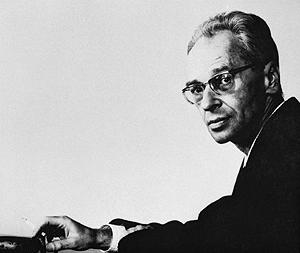
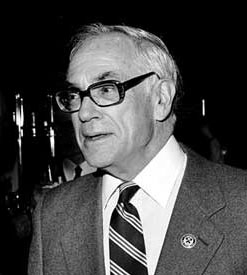
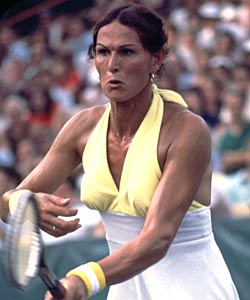
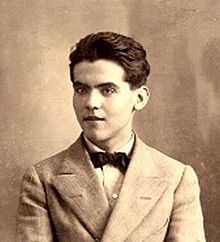
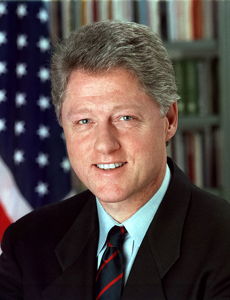
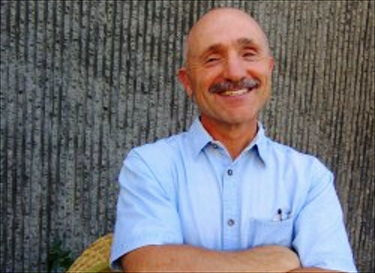
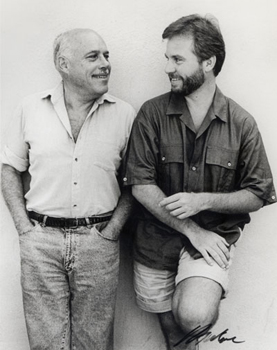 Mark Thompson (R) with partner Malcolm Boyd
Mark Thompson (R) with partner Malcolm Boyd